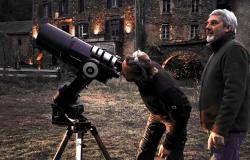Alexyz3d / Getty Images/iStockphoto
Megaconstellations like Starlink are a time bomb for the ozone layer, study finds
SPACE – By the time the problem starts to arise, it may already be too late. A study published in the journal Geophysical Research Letters on June 11 takes stock of a hitherto largely unknown consequence of the proliferation of satellites. And the forecasts are cause for concern if solutions are not found quickly.
What the Astrophysicist team of the University of Southern California, in California, studied the impact of re-entry into the atmosphere of satellites. When a satellite in low orbit is at the end of its life, it uses its last strength (what fuel remains) to descend towards the Earth, and burn in the atmosphere under the action of air friction. .
The technique works well… Too well. Almost every day, satellites whose mission has ended or which are malfunctioning, elements of various rockets travel from space to earth to disperse in tiny dust several tens of kilometers above our planet. heads. But that’s the problem. Above our heads, there is, among other things, the ozone layer, which protects us from solar radiation.
Ozone destroyer
It is the impact of these re-entries, and the dispersion of dust, on the ozone layer that our study highlights. As they disappear into the atmosphere, the satellites break down into various nanoparticles. Among them, aluminum oxide. “A typical 250 kg satellite generates 30 kg of aluminum oxide” burning, thus explain the researchers.
This chemical compound, formed by the aluminum contained in the satellite in contact with the air, is quite simply an ozone destroyer. Not directly: the oxide does not react with ozone, but activates chlorine, a powerful destroyer of the ozone layer.
In the 1990s, this reaction had already been observed, but without causing concern: the rate of satellite launches had nothing in common with today, and the concept of megaconstellations in low orbit, like that of Starlink ( Elon Musk’s network) or OneWeb, was science fiction. But since then, everything has changed.
Today, there are 8,100 satellites in low orbit. Starlink has authorization to launch 12,000 more in the coming years, and plans to reach 45,000 satellites launched. Objects with a particularly short lifespan: 112 satellites returned to burn in the atmosphere in 2022, compared to 102 in 2021… It was 6 in 2010. The proportions no longer have anything to do with it, nor does the induced pollution.
In 2050, dramatic consequences
Thus, in 2022, the dispersion of satellites was responsible, according to the study, for a 29.5% increase in aluminum in the atmosphere above normal. This is 17,000 tonnes of aluminum spread between 50 and 120 kilometers above the ground. The study’s forecasts, at the intense rate at which megaconstellations are launched, give an excess of oxide of up to 640% above the natural level in the mesosphere…
Those most keen on the subject will then note that it is not in the mesosphere, but in the stratosphere, between 20 and 50 kilometers from us, that the ozone layer is located: this is where it is located. This is a time bomb.
The team thus calculated the accumulation, in recent years, of tons of aluminum oxide could take up to thirty years to descend to the level of the ozone layer, and do still incalculable damage. This is why we must act immediately, and study the behavior of this oxide in more depth, before the fallout is fatal to our ozone layer, by 2050.
Also see on Le HuffPost :
Reading this content may result in cookies being placed by the third party operator who hosts it. Taking into account the choices you have expressed regarding the deposit of cookies, we have blocked the display of this content. If you wish to access it, you must accept the “Third Party Content” category of cookies by clicking on the button below.
Play Video






